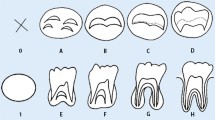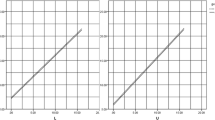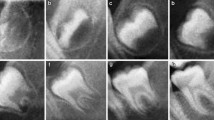Abstract
A cross-sectional study was carried out to assess chronological age estimation based on the stages of third lower molar development, following the eight stages (A–H) method of Demirjian et al. The final sample consisted of 1,054 orthopantomograms from Spanish individuals of known chronological age (range 14–21 years) and gender (462 males and 592 females). Results showed a stronger correlation for males (r2=0.54) than for females (r2=0.45). Root formation occurred earlier in males than females, in stages 5, 6 and 7. The mean difference between chronological and estimated age was −0.10 years (±1.23 SD) for left third molar, and −0.07 years (±1.22 SD) for right third molar, with slight variations regarding sex. Comparative tables are provided regarding medicolegal questions concerning age 18 prediction in the Spanish population, showing that legal age is reached in stage 7 (G) by women and in stage 8 (H) by men. No differences have been observed between sides (p<0.0001). Differences were observed between Spaniards and other previously studied populations. Third molar maturity takes place earlier in the Spanish than French-Canadian, Scandinavian, American, German, Japanese and South African populations and is more similar to US Hispanics in root development.

Similar content being viewed by others
References
Bolaños MV, Moussa H, Manrique MC, Bolaños MJ (2003) Radiographic evaluation of third molar development in Spanish children and young people. Forensic Sci Int 133:212–219
Demirjian A, Goldstein H, Tanner JM (1973) A new system of dental age assessment. Hum Biol 42:211–227
Frucht S, Schnegelsberg C, Schulte-Mönting J, Rose E, Jonas I (2000) Dental age in southwest Germany. A radiographic study. J Orofac Orthop 61:318–329
Hunt EE, Gleiser I (1955) The estimation of age and sex of preadolescent children from bones and teeth. Am J Phys Anthropol 13:479–487
Kieser JA (1990) Human adult odontometrics: the study of variation in adult tooth size. Cambridge University Press, New York
Kullman L, Johanson G, Åkesson L (1992) Root development of the lower third molar and its relation to chronological age. Swed Dent J 16:161–167
Levesque GY, Demirjian A, Tanguay R (1981) Sexual dimorphism in the development, emergence and agenesis of the mandibular third molar. J Dent Res 60:1735–1741
Mincer HH, Harris EF, Berryman HE (1993) The A.B.F.O. study of third molar development and its use as an estimator of chronological age. J Forensic Sci 38:379–390
Moorrees CFA, Fanning EA, Hunt EE (1963) Formation and resorption of three deciduous teeth in children. Am J Phys Anthropol 21:99–108
Nambiar P (1996) Third molars in the establishment of adult status. A case report. J Forensic Odonto-stomatol 14:30–33
Nolla CM (1960) The development of the permanent teeth. J Dent Child 27:254–266
Olze A, Schmeling A, Taniguchi M, Maeda H, Van Niekerk P, Wernecke KD, Geserick G (2004) Forensic age estimation in living subjects: the ethnic factor in wisdom teeth mineralization. Int J Leg Med 118:170–173
Olze A, Bilang D, Schmidt S, Wernecke KD, Geserick G, Schmeling A (2005) Validation of common classification systems for assessing the mineralization of third molars. Int J Leg Med 119:22–26
Pirinen S (1995) Endocrine regulation of craniofacial growth. Acta Odontol Scand 53:179–185
Schmeling A, Kaatsch H-J, Marré B, Reisinger W, Riepert T, Ritz-Timme S, Rösing FW, Rötzscher K, Geserick G. Guidelines for Age Estimation in Living Individuals in Criminal Proceedings. Study Group of Forensic Age Estimation of the German Association for Forensic Medicine. http://www.charite.de/rechtsmedizin/agfad/empfehlungen/empfehlung_strafverfahren_eng.pdf
Schmeling A, Olze A, Reisinger W, Rösing FW, Geserick G (2003) Forensic age diagnostics of living individuals in criminal proceedings. Homo 54:162–169
Schmeling A, Schulz R, Reisinger W, Muhler M, Wernecke KD, Geserick G (2004) Studies on the time frame for ossification of the medial clavicular epiphyseal cartilage in conventional radiography. Int J Leg Med 118:5–8
Solari AC, Abramovitch K (2002) The accuracy and precision of third molar development as an indicator of chronological age in Hispanics. J Forensic Sci 47:531–535
Thorson J, Hägg U (1991) The accuracy and precision of the third mandibular molar as an indicator of chronological age. Swed Dent J 15:15–22
Ubelaker DH (1987) Estimating age at death from immature human skeletons: an overview. J Forensic Sci 32:1254–1263
Yaacob H, Nambiar P, Naidu MD (1996) Racial characteristics of human teeth with special emphasis on the Mongoloid dentition. Malays J Pathol 18:1–7
Acknowledgements
We wish to thank Michael O’Leary for his assistance in translation.
Author information
Authors and Affiliations
Corresponding author
Rights and permissions
About this article
Cite this article
Prieto, J.L., Barbería, E., Ortega, R. et al. Evaluation of chronological age based on third molar development in the Spanish population. Int J Legal Med 119, 349–354 (2005). https://doi.org/10.1007/s00414-005-0530-3
Received:
Accepted:
Published:
Issue Date:
DOI: https://doi.org/10.1007/s00414-005-0530-3




